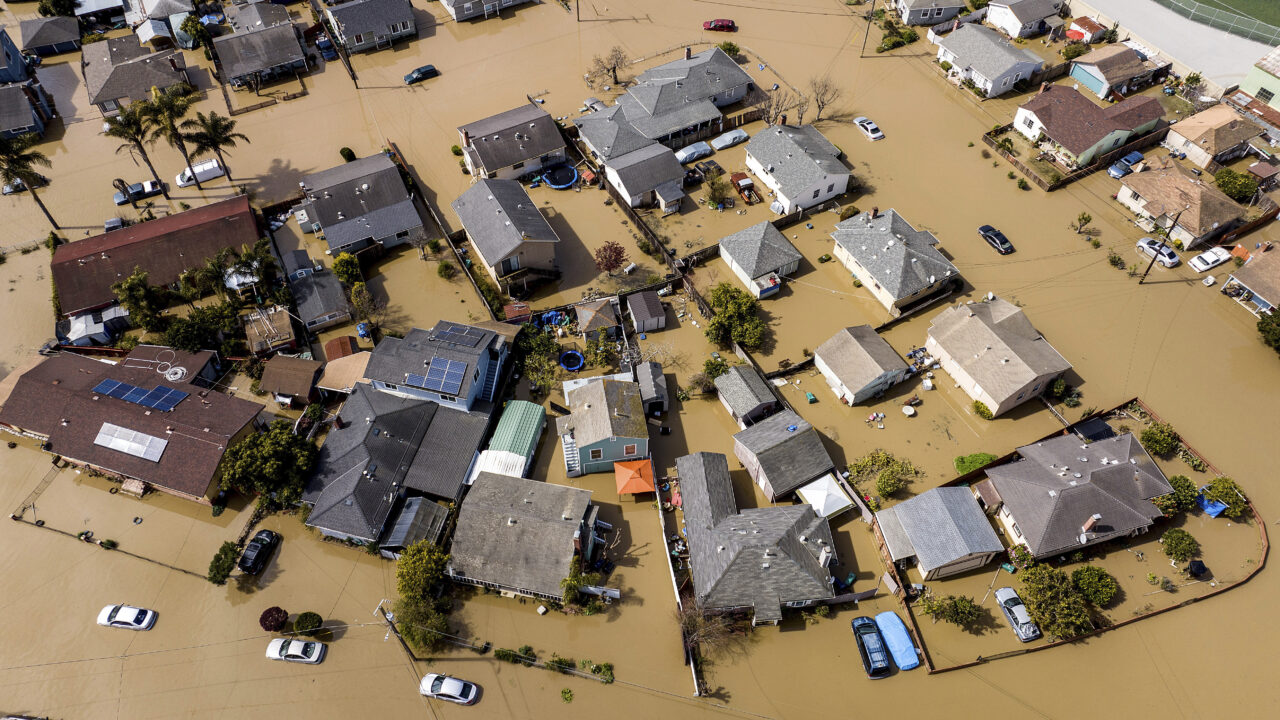Atmospheric River Storms in California
Atmospheric rivers dumped historic rain and snow on California and beyond. What happens next? Floodwaters Monterey County, Calif., on Monday, March 13, 2023. AP Photo / Noah Berger
Floodwaters Monterey County, Calif., on Monday, March 13, 2023. AP Photo / Noah Berger
From late December through January 2023, a total of nine atmospheric river storms swept across California, dumping 32 trillion gallons of water in three weeks and killing at least 22 people before moving inland. February and March brought still more. In late February, the Bay Area hills were blanketed in several inches of rarely seen snow. In early March, residents in Mendocino and Lake counties were snowed in for more than a week, and the snowpack statewide topped 200% of normal, reaching historic levels in the Central and Southern Sierras. On March 11, a levee burst on the Pajaro River, forcing thousands of residents in the farmworker community of Pajaro to evacuate as floodwaters submerged their homes in the middle of the night and drowned strawberry and lettuce fields.
Though California has been hardest hit, these storms—which typically originate near Hawai’i and flow east, dumping most of their moisture over the West Coast—have also impacted the Intermountain West, dropping rain and snow over the entire region.
More storms are forecast through mid-March. After that, meteorologists expect this year’s parade of atmospheric rivers to slow down. But the saturated landscape, historically full reservoirs and massive snowpack they leave behind will continue to affect drought conditions and fire risk well into the year, and may increase the risk of major flooding as all that snow melts.
Here’s what you need to know about this year’s unusual series of storms, and what’s still to come:
What is an atmospheric river?
Atmospheric rivers are narrow bands of moisture that start in the tropics and flow toward the western coasts of North America, South America and Europe, like rivers in the sky. “They can carry an amount of water roughly equivalent to the average flow (in cubic feet per second) at the mouth of the Mississippi,” said Matt Solum, a response and preparedness specialist at the National Weather Service’s Western Region. When the storms reach land, they release it all, often accompanied by tree-toppling winds. The strongest ones push inland, snarling the Intermountain West with snow.
Atmospheric rivers are responsible for most of the extreme flood events in the Western U.S., but they’re also critical to the region’s water resources. The National Oceanic and Atmospheric Administration (NOAA) estimates that just a few such storms each year provide up to half of the West’s precipitation, filling reservoirs and bolstering snowpack in a region that is otherwise increasingly parched.
One hallmark of climate change is the simultaneous appearance of drier droughts and wetter storms— what climatologists call weather “whiplash.”
What damage do atmospheric rivers cause?
When these storms hit, they can unleash floodwaters, send rockslides down steep or fire-scarred terrain, slam the coast with extreme waves, and topple trees and powerlines, endangering lives. Infrastructure designed to protect communities from flooding may be threatened, too: Scientists have long warned that the nation’s aging dams weren’t built to withstand a new era of floods. In 2017, the spillway of California’s Oroville Dam cracked under the pressure of atmospheric river rainfall, forcing the evacuation of 180,000 people downstream.
This year’s series of back-to-back storms brought extra danger. In areas already saturated with the previous storms’ rain, soils and riverbanks couldn’t handle any more water. Even some of the weaker storms caused minor and major flood events.
As climate change progresses, storms like this are intensifying: In 2022, researchers at Scripps Institution of Oceanography found that damages from atmospheric river-caused floods could triple by the end of the century if action is not taken to reduce global emissions. Currently, the damage averages about $1 billion annually in the U.S.
Why did California see so many atmospheric rivers this year?
While the causes and impacts of this year’s storms will be studied for years to come, weather experts say that they follow what climate change models have predicted for years. Warmer air holds more moisture—about 7% more for every 1.8 degrees Fahrenheit (1 degree Celsius)—so as ocean and air temperatures rise, storms become more potent.
One hallmark of climate change is the simultaneous appearance of drier droughts and wetter storms— what climatologists call weather “whiplash.” “I know this is a surprise to a lot of folks, but that’s going to be driven primarily by the wet side more than the dry side,” said UCLA climatologist Daniel Swain on his Weather West Youtube channel. “The wets will become even wetter than the dries will become drier.” Storms will get much more intense, even as the West is wracked with drought.
And while seasonal fluctuations and the El Niño Southern Oscillation mean that atmospheric rivers are most likely to hit California during the winter months of December through March, the same tropical storms are common in the Pacific Northwest, British Columbia and Southeast Alaska in spring and autumn—and influence the entire region.
Could this year’s atmospheric rivers end the drought?
In the short term, Swain said, this year’s storms will dramatically alleviate drought symptoms across the West. Ecosystems that have been suffering without water will see some recovery, most reservoirs statewide are near or above historic averages, and snowpack should keep higher elevations wet through the year.
“This will probably stave off the worst-case scenario predictions for the Colorado Basin this year as well,” Swain said, due to the snow accumulation across that basin.
But unless intense storm series like this happen many years in a row, they are unlikely to do much in the long term. As global temperatures rise, drought conditions in the West are driven more by increased evaporation than by lack of precipitation. Even as storms get worse, drought will likely persist.
While all that snowpack means that fire risk will be low at higher elevations, wet winters typically portend bad fire seasons.
What’s the risk of flooding as snowpack melts?
After the March storms, Swain said the Southern and Central Sierra snowpack may hold more water than ever recorded: “There is a whole hell of a lot of water up there right now.” At some point, nearly all of it will melt.
If the snowpack melts gradually, flood concerns will likely be minor, Swain said. A heat wave or quickly rising temperatures could significantly elevate the risk of major floods from late March into May. But “I still don’t see a likelihood of a catastrophic flood event,” he said. This year’s storms still fall far short of the epic “ARkStorm,” a megaflood scenario outlined by scientists that was widely publicized in 2022.
What does all this moisture mean for California’s 2023 fire risk?
While all that snowpack means that fire risk will be low at higher elevations, wet winters typically portend bad fire seasons. At lower elevations, Swain said trees downed by storms plus lush underbrush fueled by moisture could cause conditions similar to 2017, when what was then the state’s wettest winter in a century led to one of the most destructive fire seasons on record. That year, wildfires destroyed nearly 10,000 structures in the state, more than the previous nine years combined.
Do atmospheric rivers help ecosystems?
Many species, including salmon, rely on periods of heavy rainfall, like those that atmospheric rivers bring. The effects of atmospheric rivers on actual rivers are mixed: Heavy flows can scour and erode creek beds, threatening whatever is living—or spawning—in them. But in some places, high flows due to atmospheric rivers have actually helped salmon get upstream—including into one California creek where they’d never been recorded before.
Your support matters…Independent journalism is under threat and overshadowed by heavily funded mainstream media.
You can help level the playing field. Become a member.
Your tax-deductible contribution keeps us digging beneath the headlines to give you thought-provoking, investigative reporting and analysis that unearths what's really happening- without compromise.
Give today to support our courageous, independent journalists.






You need to be a supporter to comment.
There are currently no responses to this article.
Be the first to respond.